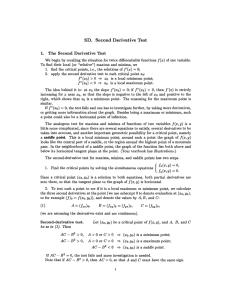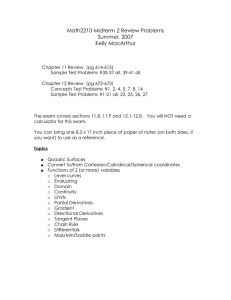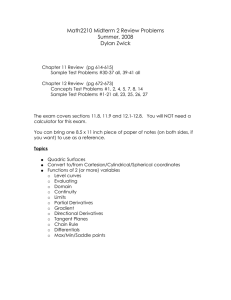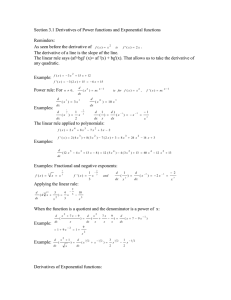Document 13739892
advertisement
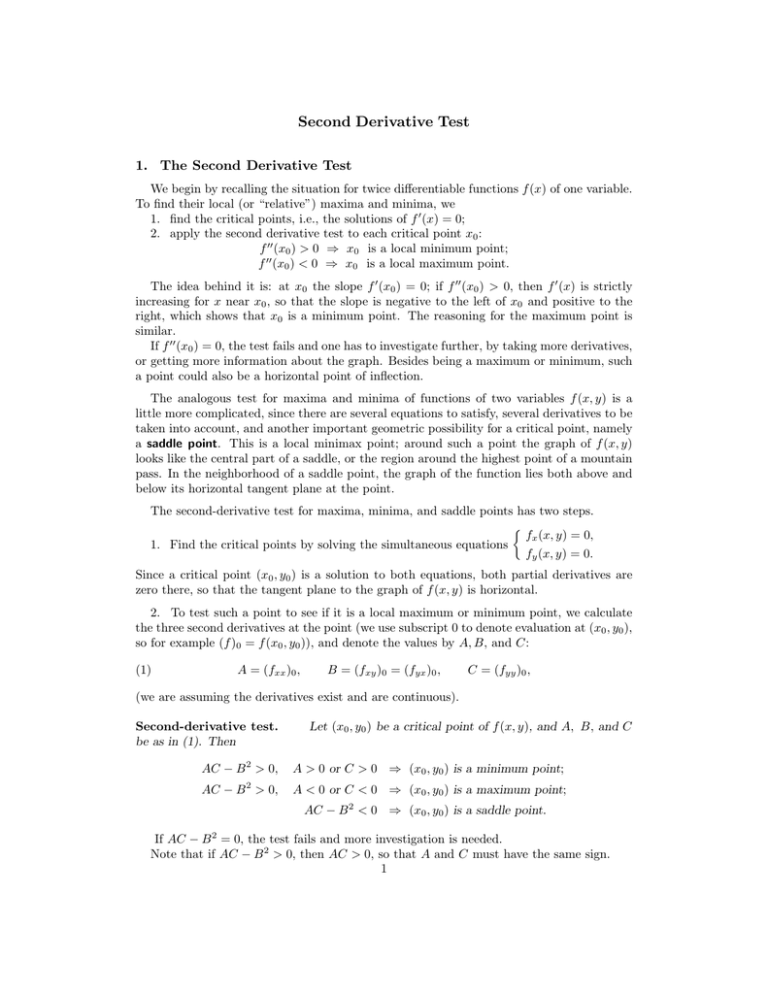
Second Derivative Test 1. The Second Derivative Test We begin by recalling the situation for twice differentiable functions f (x) of one variable. To find their local (or “relative”) maxima and minima, we 1. find the critical points, i.e., the solutions of f ′ (x) = 0; 2. apply the second derivative test to each critical point x0 : f ′′ (x0 ) > 0 ⇒ x0 is a local minimum point; f ′′ (x0 ) < 0 ⇒ x0 is a local maximum point. The idea behind it is: at x0 the slope f ′ (x0 ) = 0; if f ′′ (x0 ) > 0, then f ′ (x) is strictly increasing for x near x0 , so that the slope is negative to the left of x0 and positive to the right, which shows that x0 is a minimum point. The reasoning for the maximum point is similar. If f ′′ (x0 ) = 0, the test fails and one has to investigate further, by taking more derivatives, or getting more information about the graph. Besides being a maximum or minimum, such a point could also be a horizontal point of inflection. The analogous test for maxima and minima of functions of two variables f (x, y) is a little more complicated, since there are several equations to satisfy, several derivatives to be taken into account, and another important geometric possibility for a critical point, namely a saddle point. This is a local minimax point; around such a point the graph of f (x, y) looks like the central part of a saddle, or the region around the highest point of a mountain pass. In the neighborhood of a saddle point, the graph of the function lies both above and below its horizontal tangent plane at the point. The second-derivative test for maxima, minima, and saddle points has two steps. � fx (x, y) = 0, 1. Find the critical points by solving the simultaneous equations fy (x, y) = 0. Since a critical point (x0 , y0 ) is a solution to both equations, both partial derivatives are zero there, so that the tangent plane to the graph of f (x, y) is horizontal. 2. To test such a point to see if it is a local maximum or minimum point, we calculate the three second derivatives at the point (we use subscript 0 to denote evaluation at (x0 , y0 ), so for example (f )0 = f (x0 , y0 )), and denote the values by A, B, and C: (1) A = (fxx )0 , B = (fxy )0 = (fyx )0 , C = (fyy )0 , (we are assuming the derivatives exist and are continuous). Second-derivative test. be as in (1). Then AC − B 2 > 0, 2 AC − B > 0, Let (x0 , y0 ) be a critical point of f (x, y), and A, B, and C A > 0 or C > 0 ⇒ (x0 , y0 ) is a minimum point; A < 0 or C < 0 ⇒ (x0 , y0 ) is a maximum point; AC − B 2 < 0 ⇒ (x0 , y0 ) is a saddle point. If AC − B 2 = 0, the test fails and more investigation is needed. Note that if AC − B 2 > 0, then AC > 0, so that A and C must have the same sign. 1 2 SECOND DERIVATIVE TEST Example 1. Find the critical points of w = 12x2 + y 3 − 12xy and determine their type. Solution. We calculate the partial derivatives easily: A = wxx = 24 wx = 24x − 12y (2) B = wxy = −12 wy = 3y 2 − 12x C = wyy = 6y To find the critical points we solve simultaneously the equations wx = 0 and wy = 0; we get wx = 0 ⇒ wy = 0 y = 2x 2 y = 4x ⇒ 4x2 = 4x ⇒ x = 0, 1 (x, y) = (0, 0) ⇒ (x, y) = (1, 2) . Thus there are two critical points: (0, 0) and (1, 2). To determine their type, we use the second derivative test: we have AC − B 2 = 144y − 144, so that at (0, 0), we have AC − B 2 = −144, so it is a saddle point; at (1, 2), we have AC − B 2 = 144 and A > 0, so it is a a minimum point. A plot of the level curves is given at the right, which con­ firms the above. Note that the behavior of the level curves near the origin can be determined by using the approximation w ≈ 12x2 − 12xy; this shows the level curves near (0, 0) look like those of the function x(x − y): the family of hyperbolas x(x − y) = c, with asymptotes given by the degenerate hyperbola x(x − y) = 0, i.e., the pair of lines x = 0 (the y-axis) and x − y = 0 (the diagonal line y = x). 2. Justification for the Second-derivative Test. 3 2 1 0 −1 −2 −3 −3 −2 −1 0 The test involves the quantity AC − B 2 . In general, whenever we see the expressions B − 4AC or B 2 − AC or their negatives, it means the quadratic formula is involved, in one of its two forms (the second is often used to get rid of the excess two’s): √ −B ± B 2 − 4AC Ax2 + Bx + C = 0 ⇒ x = (3) √2A −B ± B 2 − AC (4) Ax2 + 2Bx + C = 0 ⇒ x = A 2 This is what is happening here. We want to know whether, near a critical point P0 , the graph of our function w = f (x, y) always stays on one side of its horizontal tangent plane (P0 is then a maximum or minimum point), or whether it lies partly above and partly below the tangent plane (P0 is then a saddle point). As we will see, this is determined by how the graph of a quadratic function f (x) lies with respect to the x-axis. Here is the basic lemma. Lemma. For the quadratic function Ax2 + 2Bx + C, (5) (6) (7) AC − B 2 > 0, 2 AC − B > 0, A > 0 or C > 0 A < 0 or C < 0 AC − B 2 < 0 ⇒ ⇒ ⇒ Ax2 + 2Bx + C > 0 for all x; 2 Ax + 2Bx + C < 0 for all x; � Ax2 + 2Bx + C > 0, for some x; Ax2 + 2Bx + C < 0, for some x. 1 2 3 SECOND DERIVATIVE TEST 3 Proof of the Lemma. To prove (5), we note that the quadratic formula in the form (4) shows that the zeros of Ax2 + 2Bx + C are imaginary, i.e., it has no real zeros. Therefore its graph must lie entirely on one side of the x-axis; which side can be determined from either A or C, since A > 0 ⇒ lim Ax2 + 2Bx + C = ∞; x→∞ C > 0 ⇒ Ax2 + 2Bx + C > 0 when x = 0. If A < 0 or C < 0, the reasoning is analogous and proves (6). If on the other hand AC − B 2 < 0, formula (4) shows the quadratic function has two real roots, so that its parabolic graph crosses the x-axis twice, and hence lies partly above and partly below it. This proves (7). � Proof of the Second-derivative Test in a special case. The simplest function is a linear function, w = w0 + ax + by, but it does not in general have maximum or minimum points and its second derivatives are all zero. The simplest functions to have interesting critical points are the quadratic functions, which we write in the form (the 2’s will be explained momentarily): 1 (8) w = w0 + ax + by + (Ax2 + 2Bxy + Cy 2 ). 2 Such a function has in general a unique critical point, which we will assume is (0, 0); this gives the function a special form, which we can determine by evaluating its partial derivatives at (0, 0): wxx = A (wx )0 = a wxy = B (9) (wy )0 = b wyy = C (The neat look of the above explains the 12 and 2B in (8).) Since (0, 0) is a critical point, (9) shows that a = 0 and b = 0, so our quadratic function has the form 1 (10) w − w0 = (Ax2 + 2Bxy + Cy 2 ). 2 We moved w0 to the left side since the tangent plane at (0, 0) is the horizontal plane w = w0 , and we are interested in whether the graph of the quadratic function lies above or below this tangent plane, i.e., whether w − w0 > 0 or w − w0 < 0 at points other than the origin. If (x, y) = � (0, 0), then either x = � 0 or y = � 0; say y = � 0. Then we write (10) as � � �2 � � � 2 y x x A + 2B +C (11) w − w0 = 2 y y We know that y 2 > 0 if y = � 0; applying our previous lemma to the factor on the right of (11), (or if y = 0, switching the roles of x and y in (11) and applying the lemma), we get AC − B 2 > 0, A > 0 or C > 0 AC − B 2 > 0, A < 0 or C < 0 ⇒ w − w0 > 0 for all (x, y) = � (0, 0); ⇒ w − w0 < 0 for all (x, y) = � (0, 0); ⇒ ⇒ AC − B 2 < 0 ⇒ ⇒ (0, 0) is a minimum point; (0, 0) is a maximum point; � w − w0 > 0, for some (x, y); w − w0 < 0, for some (x, y); (0, 0) is a saddle point. 4 SECOND DERIVATIVE TEST Argument for the Second-derivative Test for a general function. This part won’t be rigorous, only suggestive, but it will give the right idea. We consider a general function w = f (x, y), and assume it has a critical point at (x0 , y0 ), and continuous second derivatives in the neighborhood of the critical point. Then by a generalization of Taylor’s formula to functions of several variables, the function has a best quadratic approximation at the critical point. To simplify the notation, we will move the critical point to the origin by making the change of variables u = x − x0 , v = y − y0 . Then the best quadratic approximation is (if the x, y on the left and u, v on the right is upsetting, just imagine u and v replaced everywhere by x − x0 and y − y0 ): (13) w = f (x, y) ≈ w0 + � 1� 2 Au + 2Buv + Cv 2 ; 2 here the coefficients A, B, C are given as in (1) by the second partial derivatives with respect to u and v at (0, 0), or what is the same (according to the chain rule—see the footnote below), by the second partial derivatives with respect to x and y at (x0 , y0 ). (Intuitively, one can see the coefficients have these values by differentiating both sides of (13) and pretending the approximation is an equality. There are no linear terms in u and v on the right since (0, 0) is a critical point.) Since the quadratic function on the right of (13) is the best approximation to w = f (x, y) for (x, y) close to (x0 , y0 ), it is reasonable to suppose that their graphs are essentially the same near (x0 , y0 ), so that if the quadratic function has a maximum, minimum or saddle point there, so will f (x, y). Thus our results for the special case of a quadratic function having the origin as critical point carry over to the general function f (x, y) at a critical point (x0 , y0 ), if we interpret A, B, C as the second partial derivatives at (x0 , y0 ). This is what the second derivative test says. � Footnote: Using u = x − x0 and v = y − y0 , we can apply the chain rule for partial derivatives, which tells us that for all x, y and the corresponding u, v, we have wx = wu ∂v ∂u + wv = wu , since ux = 1 and vx = 0, ∂x ∂x and similarly, wy = wv . Therefore at the corresponding points, (wx )(x0 ,y0 ) = (wu )(0,0) , (wy )(x0 ,y0 ) = (wv )(0,0) , and differentiating once more and using the same reasoning, (wxx )(x0 ,y0 ) = (wuu )(0,0) , (wxy )(x0 ,y0 ) = (wuv )(0,0) , (wyy )(x0 ,y0 ) = (wvv )(0,0) . MIT OpenCourseWare http://ocw.mit.edu 18.02SC Multivariable Calculus Fall 2010 For information about citing these materials or our Terms of Use, visit: http://ocw.mit.edu/terms.
